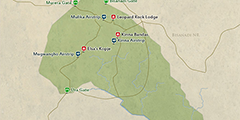
Safari Tours to Meru NP
-
![10-Day Kenyan Classic Wilderness Escape]()
10-Day Kenyan Classic Wilderness Escape
$4,399 to $5,499 pp (USD)
Kenya: Private tour
Mid-range Lodge & Tented CampYou Visit: Nairobi (Start), Meru NP, Samburu NR, Sweetwaters (Chimp Sanctuary), Lake Nakuru NP, Masai Mara NR, Lake Naivasha (Naivasha), Nairobi (End)

Tapestry of Africa Tours and Safaris
5.0/5 – 29 Reviews
-
![3-Day Meru National Park Wild Safari]()
3-Day Meru National Park Wild Safari
$633 pp (USD)
Kenya: Private tour
Mid-range Tented CampYou Visit: Nairobi (Start), Meru NP, Nairobi (End)

Adventure 360 Africa
5.0/5 – 73 Reviews
-
![7-Day Best of North National Parks Safari]()
7-Day Best of North National Parks Safari
$1,846 to $2,156 pp (USD)
Kenya: Private tour
Mid-range Lodge & Tented CampYou Visit: Nairobi (Start), Aberdare NP, Ol Pejeta Conservancy (Laikipia Plateau), Samburu NR, Meru NP, Nairobi (End)

Imara Africa Safaris
5.0/5 – 27 Reviews

 Kenya Parks
Kenya Parks











